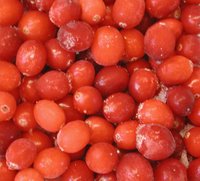Where do cranberries come from?
 I racked my brains, but couldn't recall ever seeing a cranberry tree, bush, or vine for that matter. A quick search on "how do cranberries grow" unearthed the answer. My first search result was a PDF file from Washington State University that addressed the very question. It stated that the tart little fruits grow on a "low, broadleaf evergreen vine." Wild cranberries are closely related to blueberries and are smaller than the cultured variety. They are also one of the few fruits native to
I racked my brains, but couldn't recall ever seeing a cranberry tree, bush, or vine for that matter. A quick search on "how do cranberries grow" unearthed the answer. My first search result was a PDF file from Washington State University that addressed the very question. It stated that the tart little fruits grow on a "low, broadleaf evergreen vine." Wild cranberries are closely related to blueberries and are smaller than the cultured variety. They are also one of the few fruits native toNorth America. Native Americans mashed cranberries and mixed them with deer meat to make pemmican, and they also used the berries in ceremonies and to make medicine.
The scientific name for the plant is Vaccinium macrocarpon. They grow in New England and the Pacific Northwest, but the state of Wisconsin accounts for more than half of the 70,000 tons produced annually in the U.S. The vines are cultivated in beds, called marshes in Wisconsin and bogs everywhere else.
Fresh cranberries are firm, not squishy, and will bounce if dropped. They are available from October through December, making them the perfect ingredient for many a holiday dish. We also learned that the berries contain a natural preservative called benzoic acid that helps them stay fresh for a relatively long time -- 2 to 4 weeks in the fridge, or 9 to 12 months in the freezer.
Cranberries are rich in vitamin C, and 1 cup of the fruit provides nearly a quarter of the daily requirement for the essential vitamin. Cranberries are also quite helpful in preventing and treating bladder and urinary tract infections. In addition, intensive research is currently underway to determine whether cranberry juice plays a role in preventing cancer. So the holiday season, pick up a bag at your local grocery store and join the cranberry craze
Receive post updates by Email



























 Add my feed to your Rss
Add my feed to your Rss
